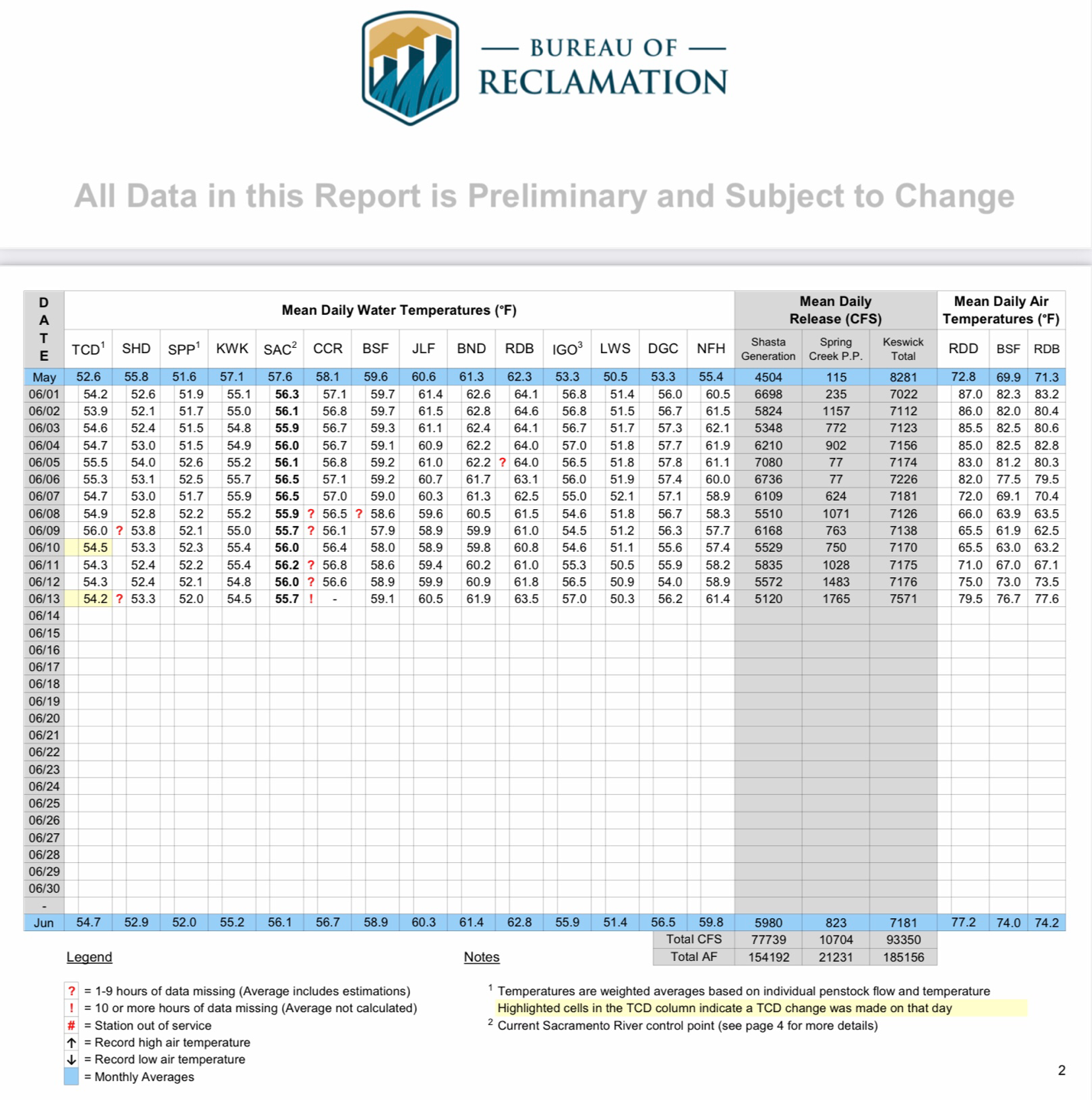In a recent 6/13/21 post, I discussed various tradeoffs of Shasta Reservoir operations on water supply deliveries, power production, and salmon survival for summer 2021. In that post I made reference to tradeoffs with peaking power production at the Shasta hydropower system. This post provides more information on those potential tradeoffs.
Peaking Power Production
Peaking power refers to the release of varying amounts of water through power turbines on a within-day schedule to meet the peak power demands of the regional electric grid. Inflows into Keswick Reservoir near Redding show the peaking power production schedule from Shasta Dam and Whiskeytown Dam into Keswick Reservoir on the Sacramento River (Figure 1). Over a recent two-day period, June 12-14 2021, hourly inflows to Keswick Reservoir ranged from 1900 cubic feet per second (cfs) to 17,500 cfs. Peak inflows were in late afternoon and evening, reflecting peak power demands. Minimum inflows were in the early morning, when power demand is low.
Peaking Power and Water Temperature from Shasta Dam
High releases for peaking power at Shasta Dam can draw warm water from near the surface of Shasta Reservoir (Figure 2). Water temperature below the dam increased from 50ºF to 56ºF in the recent example peaking periods, June 12-14. The positive relationship between dam release flow and water temperature is obvious (Figure 3).1
Peaking Power and Water Temperature from Whiskeytown Dam
In contrast to Shasta Dam, there was minimal influence on water temperatures when there were peaking releases from Whiskeytown Dam from June 12-14. The release water temperatures into Keswick Reservoir through the Spring Creek Powerhouse are minimally influenced by the flow rate (Figures 4 and 5). On June 13, there was no peaking through Spring Creek Powerhouse, but there was little variation in water temperature from peaking days on June 12 and 14.
Summary of Shasta-Keswick Operations
Shasta-Keswick operations is about to enter a new phase of summer operations. Under the Bureau pf Reclamation’s planned operations, there will be larger volumes of exports from the Trinity River system through Whiskeytown Reservoir over the summer. There will also be larger release volumes from Keswick Reservoir to meet increasing downstream contractor demands (Figure 6).
Proposed Operations
The proposed CSPA Temperature Management Plan2 for June-October, 2021 would provide a lower Keswick Dam release. First, Trinity exports would end, except for releases of 300 cfs down Clear Creek, because Trinity water releases through Spring Creek Powerhouse are already pushing the threshold temperature of 53ºF. Second, Shasta release would be limited to releases from coldwater pool at 52ºF to provide 5000 cfs total Keswick release, thereby saving Shasta storage. Third, peaking power at Shasta Dam would be minimized to ensure that warm surface waters are not drawn into the TCD gates (Figure 7) during peaking operations.
Sustaining the cold-water pool in Shasta through the summer is a function of (1) maintaining total storage and cold-water-pool volume in storage: (2) reducing Whiskeytown releases when they become too warm (>53ºF); and (3) minimizing warm water from peak power releases. Such a strategy would help save winter-run salmon eggs in the summer spawning season.

Figure 1. Inflow (cfs) to Keswick Reservoir from Shasta Dam and Spring Creek Powerhouse (cfs), June 12-14, 2021.

Figure 2. Water temperature (ºF) of the water released from Shasta Dam, June 12-14, 2021.

Figure 3. Relationship between water temperature and Shasta Dam release volume, June 12-14, 2021.

Figure 4. Total reservoir release (cfs) from Whiskeytown Dam, June 12-14, 2021. Note that of the minimum 250 cfs release, about 125 cfs were released to Clear Creek to maintain base flows and were not releases through Spring Creek Powerhouse.

Figure 5. Water temperature of water exiting the Spring Creek Powerhouse into Keswick Reservoir, June 9-14, 2021.

Figure 6. Summary of Shasta operations, June 1-13, 2021. Note SAC is gage station 5 miles below Keswick Dam on Sacramento River. Source: https://www.usbr.gov/mp/cvo/vungvari/sactemprpt.pdf

Figure 7. Shasta Dam operations and reservoir storage conditions on June 10, 2021. Source: https://www.usbr.gov/mp/cvo/vungvari/sactemprpt.pdf .
- At other times, depending on specific conditions and operations, the opposite relationship is true. See https://calsport.org/fisheriesblog/?p=3596, Figure 6, for example from 2014 when higher temperatures were associated with lower release volumes. ↩
- Referenced in https://calsport.org/fisheriesblog/?p=3714. The May 23, 2021 CSPA Temperature Management Plan proposed limiting Trinity exports to 300 cfs for the entirety of the June-October period, to be released exclusively down Clear Creek. In addition to the water temperature benefits in the Sacramento River, such operation would also conserve cold water and overall storage in Trinity Reservoir. ↩
